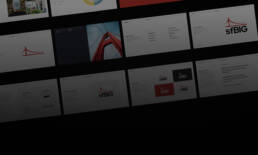Have you ever sat down to make a grocery list and thought, 'I need to stock up on more Band-Aids'? It’s funny how some brands become so popular, we forget they’re brands at all.
These names don’t just define a product – they become the universal term for an entire category of products. Whether it’s a lesson on great branding, great naming, or just great product design there’s no denying there are lessons to be learned.
From medical supplies to toys, our homes are filled with examples. Let’s look at 12 items that have become so ingrained in our everyday lives, you may not realize they’re brand names.
Popsicle
I can’t imagine a world where Popsicles didn’t exist. But an even greater shock is realizing Popsicles all started as a simple mistake, by an 11-year-old boy. In 1905 Frank Epperson left his sugary soda mix outside overnight with a stick in it. When morning came, he found the first frozen treat on his porch. Originally called “Epsicle,”(after his last name, of course), it was later rebranded as “Popsicle” by his children. Though Epperson sold the rights, Popsicles became a go-to summer treat.
By the time Unilever got hold of it in 1989, it had become a frozen icon, with over two billion sold annually. With a variety of flavors and easy-to-hold sticks, they were a hit among kids and adults alike. While they can’t stop you and I from calling all frozen treats on a stick “Popsicles”, Unilver fiercely protects its trademark. This has given way to the fine print on competitor’s boxes that say “ice pops” and “sweet freezer pops”. It’s hard to imagine a summer without this frozen treat, and even harder to think of any other name for it.
Chapstick
Lip balms have been around since before the Egyptians. It’s easy to say no one, including ancient civilizations, likes having chapped lips. But it wasn’t until sometime in the 1890s that Dr. Charles Fleet, a pharmacist in Lynchburg, VA, created the first Chapstick. The original Chapstick was said to look more like a small candle than the tube we know today. Fast forward to 1912, and Fleet asked his friend John Morton if he wanted to purchase the rights to Chapstick. John said yes and bought Chapstick for just $5. He then reimagined it into the iconic twist-up tube we know today.
Chapstick has seen various iterations over the years, with new flavors and even sun-protective versions becoming available. Despite the competition in the lip care market, Chapstick remains one of the most recognized names in lip care products, proving that sometimes, the original really is the best.
Band-Aid
Bandages have been around since before recorded medicine, and they’re one of my favorite examples of a household brand name. Before the 1920s, gauze and tape were the most popular household bandages, but they were difficult to manage. In 1921, Earle Dickson decided to help his wife, who often struggled to keep bandages tidy while cooking and cleaning.
Dickson developed a self-adhesive bandage. Impressed with the invention, Johnson & Johnson, where Dickson worked, began manufacturing Band-Aids later that year. Initially, sales were slow, but Johnson & Johnson is known for their clever marketing. They gave their product to Boy Scouts and soldiers – two groups known for getting frequent scrapes. The product went viral and turned Band-Aid into a household name synonymous with quick, convenient wound care.
Beyond marketing, Band-Aid’s success also came from its durability and simplicity. It allowed people to patch up minor cuts and scrapes without needing help. Over time, it’s evolved into different shapes, sizes, and even fun designs for kids. Nowadays, no one even thinks twice about the brand; “Band-Aid” is synonymous with wound care.

Photo: Unsplash
Rollerblade
Inline skates weren’t new when Scott and Brennan Olson revamped the concept in the 1980s. However, their take on skates, branded as Rollerblade, turned it into a worldwide craze. Originally designed for hockey training, Rollerblades streamlined the design and used more durable materials. The Olson’s design used polyurethane wheels, which allowed for smoother gliding and better control, compared to the older, bulkier designs that used metal or wooden wheels. They also added reliable braking systems and more comfortable boots, making them easier and safer.
By the 1990s, “rollerblading” had become a cultural phenomenon. Nowadays, people still refer to any inline skate as “rollerblades”. Even as the fad has faded, the Rollerblade name continues to represent the entire category of inline skates.
Dumpster
The next time you toss something into a giant trash bin, remember the Dempster brothers. In 1936, they created a mobile waste system they dubbed the “Dumpster.” The name, a mix of “Dempster” and “dump,” became so common that people still refer to any large garbage container as a dumpster. (In fact, it’s still trademarked!)
Dumpster isn’t just a popular brand name. The company also changed the waste management landscape for public spaces. Large, mobile trash containers made cleaning up after large events and construction projects easier. That’s probably why almost 90 years later, “dumpster” has become the universal term for any large waste bin.
Jacuzzi
You may know Jacuzzi for its luxurious in-home relaxation, but they didn’t start out that way. The Jacuzzi brothers originally invented their whirlpool baths to provide hydrotherapy for arthritis relief. But what started as a medical device in the 1940s became a status symbol of relaxation by the 1960s. Today, “Jacuzzi” is practically interchangeable with any hot tub, no matter the brand.
Jacuzzi’s evolution from medical treatment to a luxury symbol wasn’t accidental. The company knew their devices could be dual-marketed. With clever marketing and product enhancements, the company turned its therapeutic product into something associated with indulgence and relaxation, cementing its name as a cultural icon. Jacuzzi tubs still elicit a sense of luxury to this day. So, the next time you’re soaking in a tub with jets, you can thank the Jacuzzi brothers for adding luxury to your bath.

Photo: Unsplash
Jell-O
Jell-O was created in 1897 by Pearle Wait, a cough syrup maker who experimented with mixing gelatin and fruit flavoring. Initially, it didn’t sell well. In 1899, Orator Frank Woodward bought the rights to Jell-O’s name and mixture and began aggressively marketing it. He sent salesmen door-to-door with free samples and recipe books to familiarize households with the product.
The product did well, but it didn’t cement itself as an American favorite until later. Jell-O gained popularity in the 1920s when the brand became a symbol of affordability during the Great Depression. Its fun, jiggly texture made it a hit for family gatherings and celebrations. While not as popular, Jell-O remains a nostalgic treat today.
Coke
Coca-Cola was invented in 1886 by Dr. John Stith Pemberton, a pharmacist in Atlanta, GA. He brought a jug of his syrup to a local pharmacy (Jacobs’ Pharmacy), where it was mixed with carbonated water and sold as a soda fountain drink for only five cents a glass. Pemberton’s longtime friend and bookkeeper, Frank Robinson, created the name “Coca-Cola” and designed its iconic script logo.
You’d think with how big the brand is now, it must have been flying off the shelves but you’d be wrong. In its first year, Coca-Cola sold just nine glasses a day. However, in 1888, businessman Asa Candler purchased interest in the company and dramatically expanded the brand through clever marketing and distribution.
By the early 1900s, Candler gained full control of the company and saw that Coca-Cola was sold in bottles nationwide. Today, “Coke” is not only a leader in the soft drink market but is often used as a generic term for cola beverages around the world.
Bubble Wrap
Believe it or not, Bubble Wrap was originally designed as wallpaper. (You can imagine how well that went over.) In 1957 two engineers, Alfred Fielding and Marc Chavannes accidentally created Bubble Wrap while trying to create textured wallpaper by sealing two shower curtains together. They ended up creating a material filled with air bubbles. Originally, they thought it was a failed product. It wasn’t until they realized how great the material was for protecting fragile items that they put it on the market.
In 1960, they opened the Sealed Air Corporation to market their product as revolutionary protective packaging material they trademarked, Bubble Wrap. It was a hit in industries like postage, shipping, and moving. While there are many impersonators, Bubble Wrap is still trademarked by the Sealed Air Corporation to this day.
Hula-Hoop
Though people have been playing with hoops for centuries, it wasn’t until Wham-O introduced the plastic Hula-Hoop in 1958 that the world went wild. Millions of Hula-Hoops sold in the first few months, turning a simple toy into a cultural phenomenon. Even today, the Hula-Hoop is used for fitness and fun, proving that it’s much more than a passing fad.
The Hula-Hoop’s success was largely due to Wham-O’s knack for creating toys that tapped into people’s sense of play and competition. It wasn’t just a toy—it was an exercise tool, a game, and even a performance piece.
Super Glue
Super Glue’s story is a perfect example of how a great idea can find success, even with a few false starts. In 1942, Dr. Harry Coover discovered cyanoacrylate while working on developing clear plastic gun sights for World War II. Initially, he dismissed the material because it was too sticky. It wasn’t until 1951, while Coover was working at Eastman Kodak, that he and his team realized cyanoacrylate’s potential as a commercial adhesive.
It was first sold commercially in 1958 under the name “Eastman 910.” A year later, another company began marketing it as Super Glue, and that name stuck. From fixing broken dishes to quick repairs, Super Glue has been saving the day ever since. It quickly became a household name. Over time, the name is so renowned that most people think it refers to the type of glue.
Crock-Pot
The last item on our list is taking us back into the kitchen. The Crock-Pot was invented in the 1970s by Irving Naxon, who was inspired by his mother’s method of slow-cooking meals in a stoneware pot. He originally named it the “Naxon Beanery All-Purpose Cooker”.
In 1971, Naxon sold the design to Rival Manufacturing, who rebranded it as the Crock-Pot. (I think all the marketers reading this can spot why.) It quickly became a kitchen essential, offering busy families a way to prepare meals with minimal effort. It grew in popularity as families began to have both parents enter the workforce. By allowing food to cook slowly over hours, the Crock-Pot brought convenience to home cooking, revolutionizing meal preparation.
Today, the term “Crock-Pot” is often used to describe any slow cooker but make no mistake – the original Crock-Pot is still going strong. With the rise of newer kitchen gadgets like the Instant Pot carving out their own path to household fame, the Crock-Pot continues to hold its place as a trusted kitchen staple. After all, when it comes to easy, slow-cooked meals, there’s nothing quite like the original.

Photo: Food & Wine
Why Do Some Household Brands Become Part Of Our Language?
The path from brand name to common-tongue isn’t easy. These 12 items didn’t just solve everyday problems – they became integral to our daily lives. Their stories show how smart branding, a bit of luck, and practical usefulness can transform an invention into a household name. Whether you’re designing a product or running a business, there’s something to learn from how these items turned from clever innovations into everyday essentials.
If you loved this article, make sure you check out my blog post on The Secret Lives of Objects, where I dive into hidden uses for items you use and love.
Borja Zamora
A Barcelona native but San Francisco based, Borja explores digital marketing and design through articles, images, and quotes.
Related Posts
December 16, 2024
10 Groundbreaking Branding Trends Shaping the Future in 2025
Explore 10 innovative branding trends for 2025, from AI personalization to…
August 27, 2024
The Secret Lives of Objects: Hidden Design Stories in Everyday Product Designs
Great design is all around you. In our daily lives, we interact with objects…
April 30, 2024
sfBIG: A Non-Profit Website Re-Design & Branding Case Study
After successfully rebranding several non-profits, I was honored to be asked to…
March 22, 2024
Lessons From The Worst Rebrands in History
What were the worst rebrands in history? Let’s look at 7 lessons in bad…
Related Posts
December 16, 2024
10 Groundbreaking Branding Trends Shaping the Future in 2025
Explore 10 innovative branding trends for 2025, from AI personalization to…
August 27, 2024
The Secret Lives of Objects: Hidden Design Stories in Everyday Product Designs
Great design is all around you. In our daily lives, we interact with objects…
April 30, 2024
sfBIG: A Non-Profit Website Re-Design & Branding Case Study
After successfully rebranding several non-profits, I was honored to be asked to…
March 22, 2024
Lessons From The Worst Rebrands in History
What were the worst rebrands in history? Let’s look at 7 lessons in bad…







